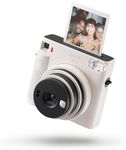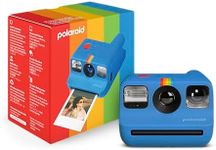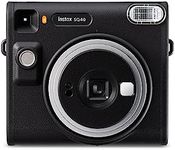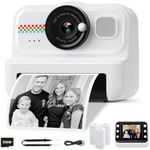Buying Guide for the Best Instant Cameras
Instant cameras are a fun and nostalgic way to capture moments and get physical photos instantly. When choosing an instant camera, it's important to consider several key specifications to ensure you get the best fit for your needs. Here are the main specs to look at and how to navigate them.Film FormatFilm format refers to the size and type of film the camera uses. This is important because it affects the size of your photos and the availability of film. Common formats include mini, square, and wide. Mini film is small and portable, great for casual snapshots. Square film offers a classic look and is slightly larger, making it good for more detailed shots. Wide film provides the largest prints, ideal for group photos or landscapes. Choose a format based on how you plan to use your photos and your preference for photo size.
Lens QualityLens quality determines the sharpness and clarity of your photos. Higher quality lenses produce clearer, more detailed images. Lenses can be made of plastic or glass, with glass generally offering better quality. If you want high-quality, sharp images, look for a camera with a glass lens. For casual use and fun snapshots, a plastic lens may be sufficient.
Exposure ControlExposure control allows you to adjust the brightness of your photos. This is important for getting the right lighting in different environments. Some cameras have automatic exposure control, which adjusts settings for you, making it easy for beginners. Others offer manual controls, giving you more creative freedom but requiring more skill. If you’re new to photography, an automatic exposure control might be best. If you enjoy experimenting with settings, look for a camera with manual options.
FlashA built-in flash helps illuminate your subject in low-light conditions. This is important for taking clear photos indoors or at night. Some cameras have automatic flash, which activates when needed, while others allow you to control the flash manually. If you often take photos in various lighting conditions, a camera with a good flash system is essential. For outdoor or well-lit environments, flash may be less critical.
Battery TypeBattery type affects how you power your camera and how often you need to replace or recharge batteries. Instant cameras can use disposable batteries (like AA or AAA) or rechargeable batteries. Disposable batteries are convenient for travel and easy to replace, but can be costly over time. Rechargeable batteries are more eco-friendly and cost-effective in the long run, but require regular charging. Choose based on your convenience and usage habits.
Size and PortabilityThe size and portability of the camera determine how easy it is to carry around. Smaller, lighter cameras are more portable and convenient for travel or everyday use. Larger cameras may offer more features but can be bulkier to carry. Consider how and where you plan to use your camera. If you want something you can easily take with you, opt for a compact model. If you don’t mind the extra size for additional features, a larger camera might be suitable.
Additional FeaturesAdditional features can enhance your photography experience. These might include selfie mirrors, timers, multiple exposure modes, or creative filters. These features can add fun and versatility to your photography. Think about what extra functionalities you might enjoy or find useful. If you like taking selfies, a camera with a selfie mirror or timer is beneficial. For creative photography, look for cameras with multiple exposure modes or filters.



















